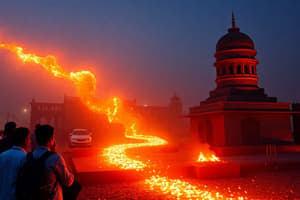Podcast
Questions and Answers
What was the main focus of India's First Five Year Plan?
What was the main focus of India's First Five Year Plan?
- Urbanization
- Industry development (correct)
- Rural-based development
- Agricultural modernization
Who initiated the Green Revolution in India?
Who initiated the Green Revolution in India?
- Indira Gandhi (correct)
- Pt.Govind Ballabh Pant
- B.R. Ambedkar
- Jawaharlal Nehru
What hindered India's economic growth in the three decades following the Green Revolution?
What hindered India's economic growth in the three decades following the Green Revolution?
- Protectionist policies (correct)
- Global market competition
- High foreign investment
- Efficient bureaucratic structure
What prompted successive Indian governments to launch reform initiatives in the late 1980s?
What prompted successive Indian governments to launch reform initiatives in the late 1980s?
Which economist provided guidance for centralized planning in post-independence India?
Which economist provided guidance for centralized planning in post-independence India?
What were some of the measures implemented by Manmohan Singh as Finance Minister in 1991?
What were some of the measures implemented by Manmohan Singh as Finance Minister in 1991?
What was a significant outcome of the liberalizing reforms in India post-1991?
What was a significant outcome of the liberalizing reforms in India post-1991?
What is one of the contemporary challenges mentioned in the text facing India despite its economic progress?
What is one of the contemporary challenges mentioned in the text facing India despite its economic progress?
What sector is highlighted as having a vast pool of skilled talent in India's emerging economy?
What sector is highlighted as having a vast pool of skilled talent in India's emerging economy?
How has India's poverty levels changed from 1980–81 to 2004–05?
How has India's poverty levels changed from 1980–81 to 2004–05?
Flashcards are hidden until you start studying
Study Notes
Understanding India's Economic Journey
India has navigated through a complex history of growth and transformation since embracing its path toward modern economics after independence in 1947. Let's explore some key milestones and characteristics of this intriguing journey toward Indian economic development.
Early Challenges and Policies
Post-independence India faced formidable challenges such as poverty alleviation, food scarcity, and unemployment, which led it down the road toward centralized planning under the guidance of economists like Jawaharlal Nehru and Pt. Govind Ballabh Pant. This approach was called the First Five Year Plan and continued until 1969, with an emphasis on industry over agriculture and urbanization instead of rural-based development.
The Green Revolution initiated by Indira Gandhi in 1965 helped increase agricultural productivity using high-yield crop varieties and improved farming techniques. However, the next three decades saw sluggish overall growth due to factors including bureaucratic red tape, lackluster foreign investment, and protectionist policies that hindered competition from global markets.
Liberalization and Reform Period
In response to these obstacles, successive governments launched several reform initiatives starting in the late 1980s. Manmohan Singh, who became Finance Minister in 1991, implemented dramatic measures such as deregulating industries, loosening import restrictions, and opening up the economy to international trade and investments. These liberalizing reforms further gained momentum during subsequent administrations and continue to shape India's present-day economy.
As a result of these changes, India witnessed significant increases in FDI inflows, fast economic growth rates averaging around 7% per year between 1991 and 2007, and substantial reductions in poverty levels—from approximately one-third of the population being below the poverty line in 1980–81 to less than one fifth in 2004–05.
Emerging Trends and Contemporary Challenges
Fast forward to today, India is well poised to become a top five world economy by 2028 according to Credit Suisse projections. It boasts an enormous consumer market with increasing purchasing power, a growing middle class, and a vast pool of skilled talent, particularly in fields like information technology services and pharmaceuticals.
However, despite impressive progress, some pressing issues remain. For instance, the gender gap continues to persist; women make up just under half of the workforce yet are paid significantly lower wages. Furthermore, corruption, weak infrastructure, and lack of sufficient social safety nets still burden many households across the country. As India moves into its next chapter of economic expansion, addressing these problems will help ensure sustainable, inclusive growth for all citizens.
This overview aims to introduce you to various facets that have shaped India's economic trajectory thus far. By understanding these dynamics, we can better appreciate India's potential while also remaining aware of the ongoing challenges ahead.
Studying That Suits You
Use AI to generate personalized quizzes and flashcards to suit your learning preferences.




